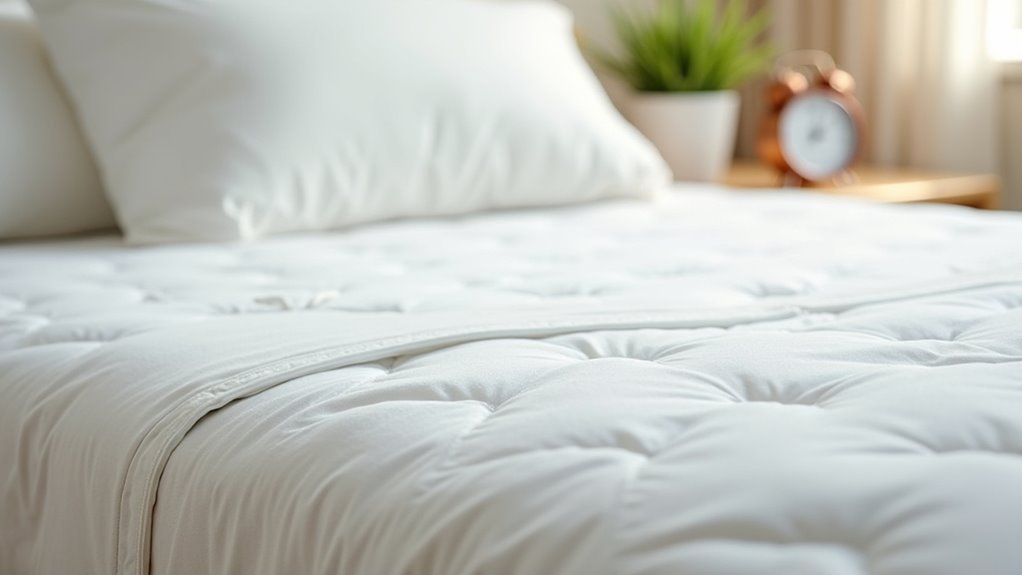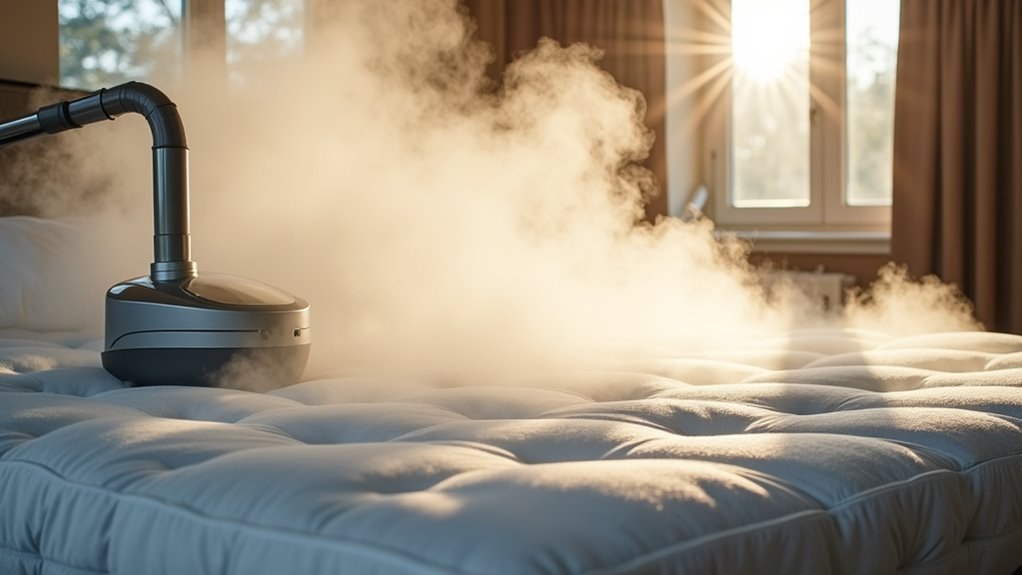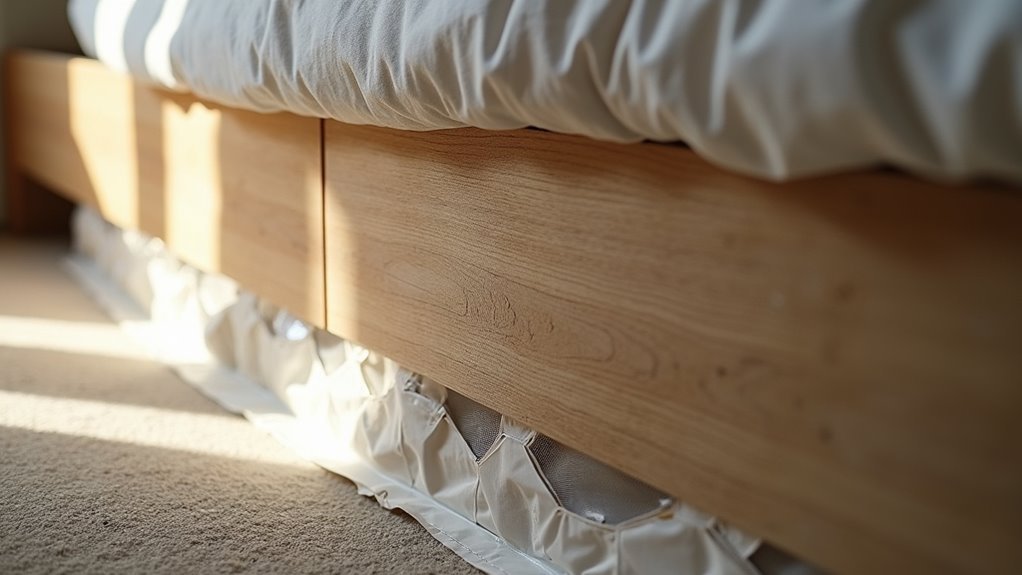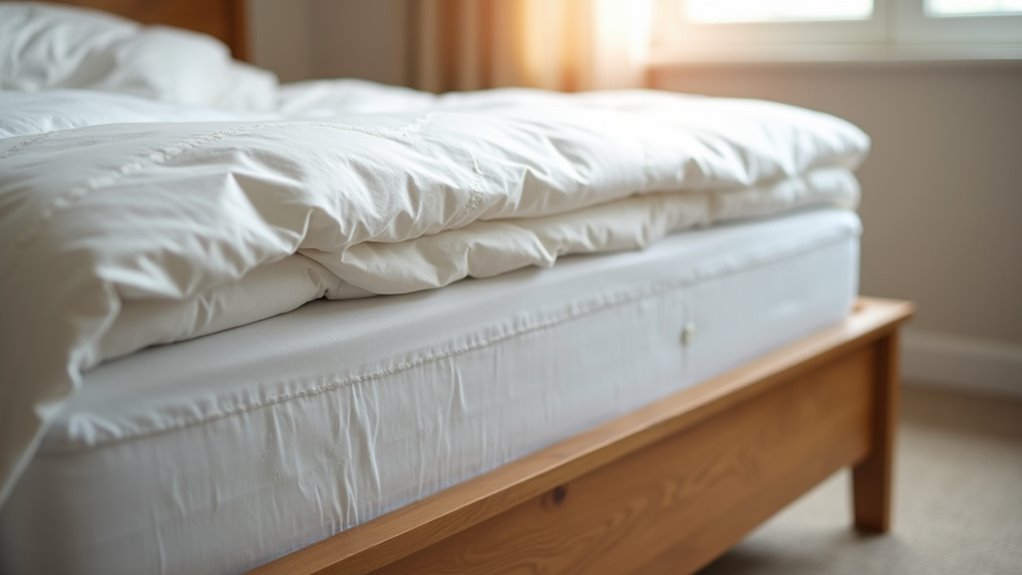You can create effective quick bed bug barriers by installing vinyl mattress encasements that trap existing bugs and block new invasions. Place adhesive tape traps around bed frame legs to prevent climbing access, and use double-sided tape to seal gaps where bugs hide. Apply steam treatment at 212°F for instant elimination on contact, and vacuum regularly while immediately disposing of contents. Seal entry points around baseboards and electrical outlets to complete your defensive perimeter and discover additional proven strategies below.
Physical Encasements and Protective Covers for Immediate Defense

When bed bugs invade your home, physical encasements and protective covers serve as your first line of defense, creating immediate barriers that trap existing pests and prevent infestations.
Mattress encasements made of vinyl considerably reduce bed bug populations by trapping bugs inside while blocking new invasions.
You’ll want bed bug-proof pillow covers that create protective barriers around your pillows, ensuring safer sleep and fewer bites.
Protective covers for box springs work by sealing tightly, making inspections easier while revealing infestation signs.
Don’t forget bed bug traps around bed frame legs—they halt movement and prevent climbing.
These physical encasements form essential components of integrated pest management strategies, complementing other methods for effective treatment against persistent bed bug problems.
Tape and Adhesive Traps Around Bed Frames and Furniture
While physical encasements provide excellent protection for your bedding, tape and adhesive traps around bed frames and furniture create an additional defensive perimeter that intercepts bed bugs before they reach your sleeping area.
Tape and adhesive traps create a defensive perimeter around bed frames, intercepting bed bugs before they reach your sleeping area.
You’ll strategically place these tape traps around bed frame legs and furniture bases, forming a physical barrier that prevents climbing access. Adhesive traps effectively capture bugs attempting to cross sticky surfaces, helping you monitor and reduce bed bug populations simultaneously.
You can use double-sided tape to seal gaps where bugs hide, enhancing barrier effectiveness.
Regular inspection and replacement guarantee continued performance while providing early detection of activity. These control measures work best as part of an Integrated Pest Management approach, combining multiple strategies for thorough bed bug elimination.
Steam Treatment and Heat Application for Instant Elimination

After establishing tape barriers around your furniture, steam treatment offers the most immediate and effective solution for eliminating bed bugs on contact.
You’ll achieve instant elimination by applying steam at 212°F directly to infested areas, killing all life stages immediately. Small steamers costing around $75 enable targeted treatment in bed bug hiding places where conventional methods can’t reach.
Professional pest control services use extensive heat treatment, raising room temperatures to 135°F-145°F for complete eradication in one day. This effective bed bug management strategy treats entire spaces simultaneously.
You can also eliminate bed bugs from textiles through high-temperature washing and drying cycles. Steam treatment reduces moisture levels in treated areas, preventing re-infestation by drying out potential hiding spots.
Vacuuming Techniques and Containment Strategies
Three proven vacuuming techniques can dramatically reduce bed bug populations when you target their preferred hiding spots systematically. Focus on seams, cracks and crevices where these pests concentrate. Use a knee-high stocking over your vacuum hose to capture bugs more effectively during removal. You’ll need to dispose of vacuum contents outside immediately to prevent re-infestation.
| Technique | Purpose |
|---|---|
| Regular vacuuming | Integrated pest management monitoring |
| Mattress encasements | Physical barrier protection |
| Bed bug traps | Detection and containment |
| Reducing clutter | Enhanced inspection access |
| Immediate disposal | Prevention of re-infestation |
These containment strategies work together as effective barriers. Mattress encasements prevent access to sleeping areas, while bed bug traps aid in monitoring pest activity. Reducing clutter facilitates thorough vacuuming and inspection, making your integrated pest management approach more successful.
Sealing Entry Points and Creating Movement Barriers

Since bed bugs can exploit even the tiniest openings, you’ll want to systematically seal all potential entry points throughout your living space.
Focus on sealing entry points around baseboards, electrical outlets, and windows using caulk or appropriate sealants. These barriers are essential for reducing bed bug access and preventing infestations from spreading.
Create effective movement barriers by positioning bed bug traps under bed legs to intercept bugs attempting to reach sleeping areas.
Install mattress encasements and box spring encasements to prevent bugs from entering or escaping these prime hiding spots.
You’ll also want to inspect and monitor upholstered furniture seams regularly, sealing any gaps you discover.
Maintain a clutter-free environment to eliminate potential hiding spots and make monitoring easier.
Frequently Asked Questions
What Surfaces Can Bed Bugs Not Crawl On?
You’ll find bed bugs can’t crawl on smooth, slippery surfaces like glass, polished metal, and plastic. They also struggle with Teflon coatings and non-textured synthetic fabrics that don’t provide traction.
Do Bed Bug Barriers Work?
Yes, bed bug barriers work effectively when you use them properly. You’ll trap existing bugs inside encasements while preventing new infestations. They’re most successful when you combine them with other treatment methods.
What Is the Best Defense Against Bed Bugs?
You’ll find mattress encasements provide your strongest defense by trapping existing bugs while preventing new infestations. Combine them with frequent high-temperature laundering, regular vacuuming, and pitfall traps for thorough protection.
What Can I Put on My Skin to Prevent Bed Bug Bites?
You can apply DEET-based repellents to your skin and clothing before sleeping. Permethrin-treated fabrics also help deter bed bugs. Essential oils like lavender provide limited protection, so always follow product labels carefully.
In Summary
You’ve got several quick barrier options to stop bed bugs immediately. Wrap your mattress and box spring in protective encasements, then place tape traps around bed legs and furniture. Steam treat infested areas for instant kills, vacuum thoroughly to remove bugs and eggs, and seal cracks where they’re entering. These combined barriers will create multiple defense layers, preventing bed bugs from reaching you while you sleep tonight.





Leave a Reply